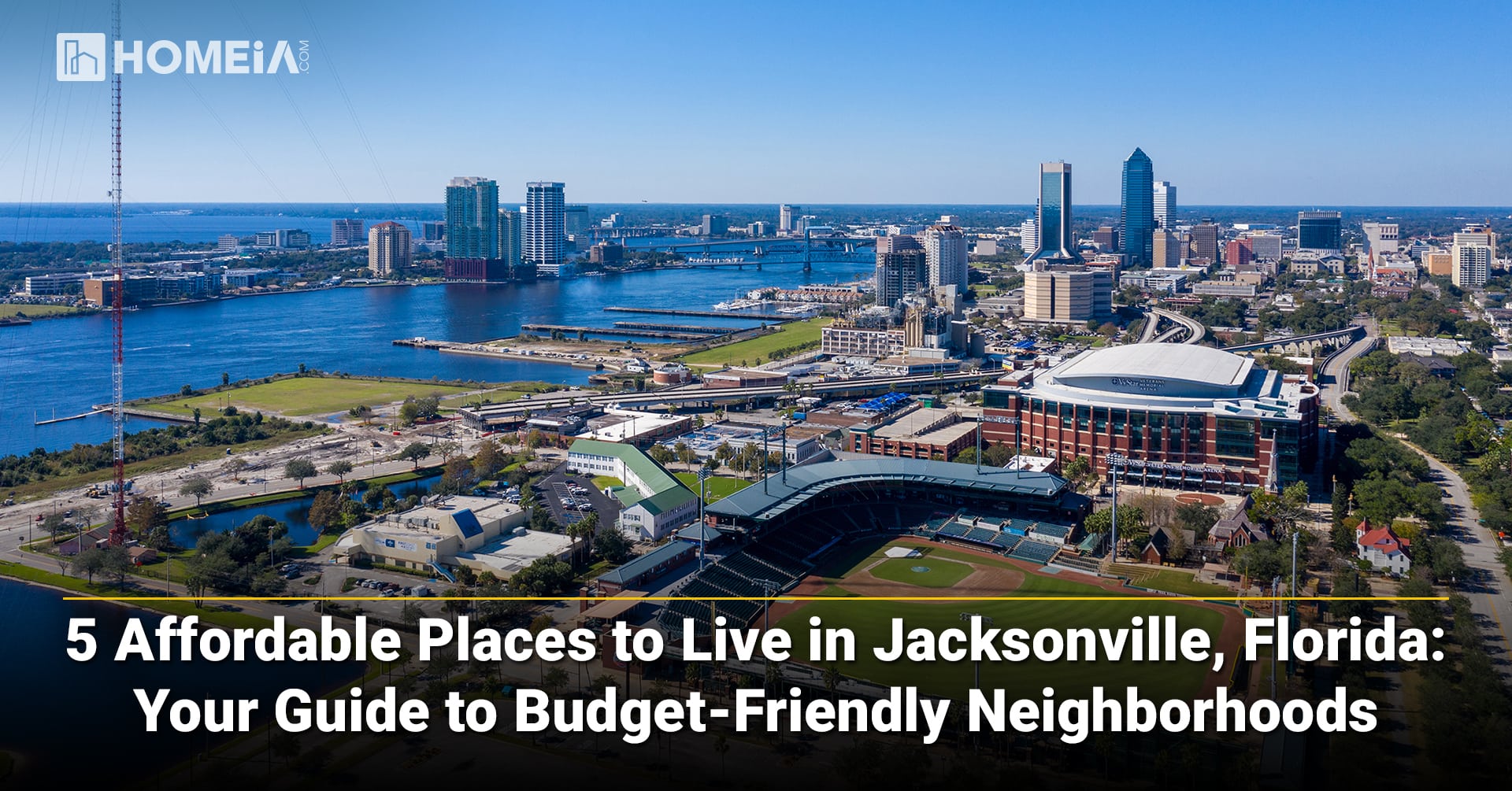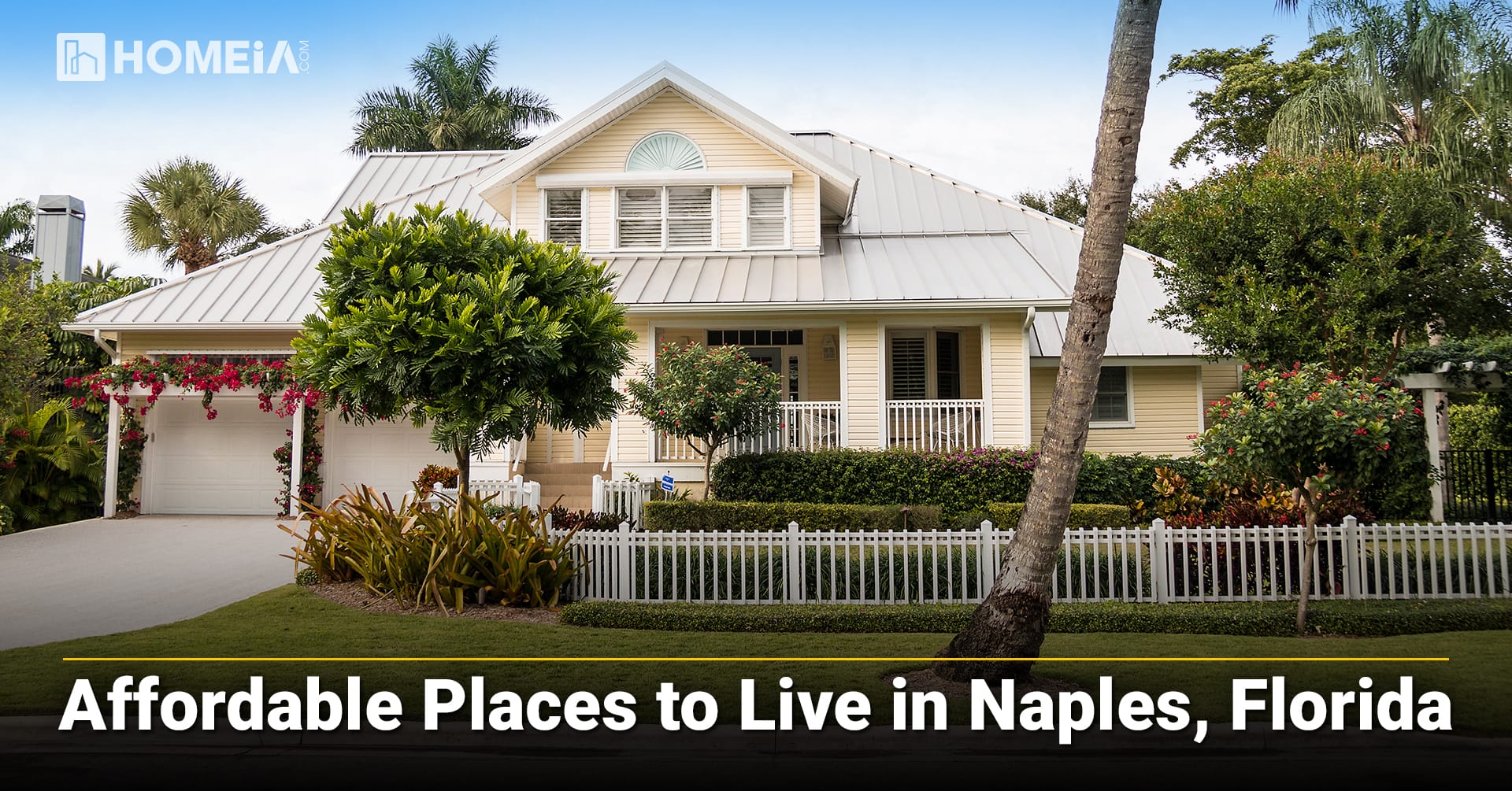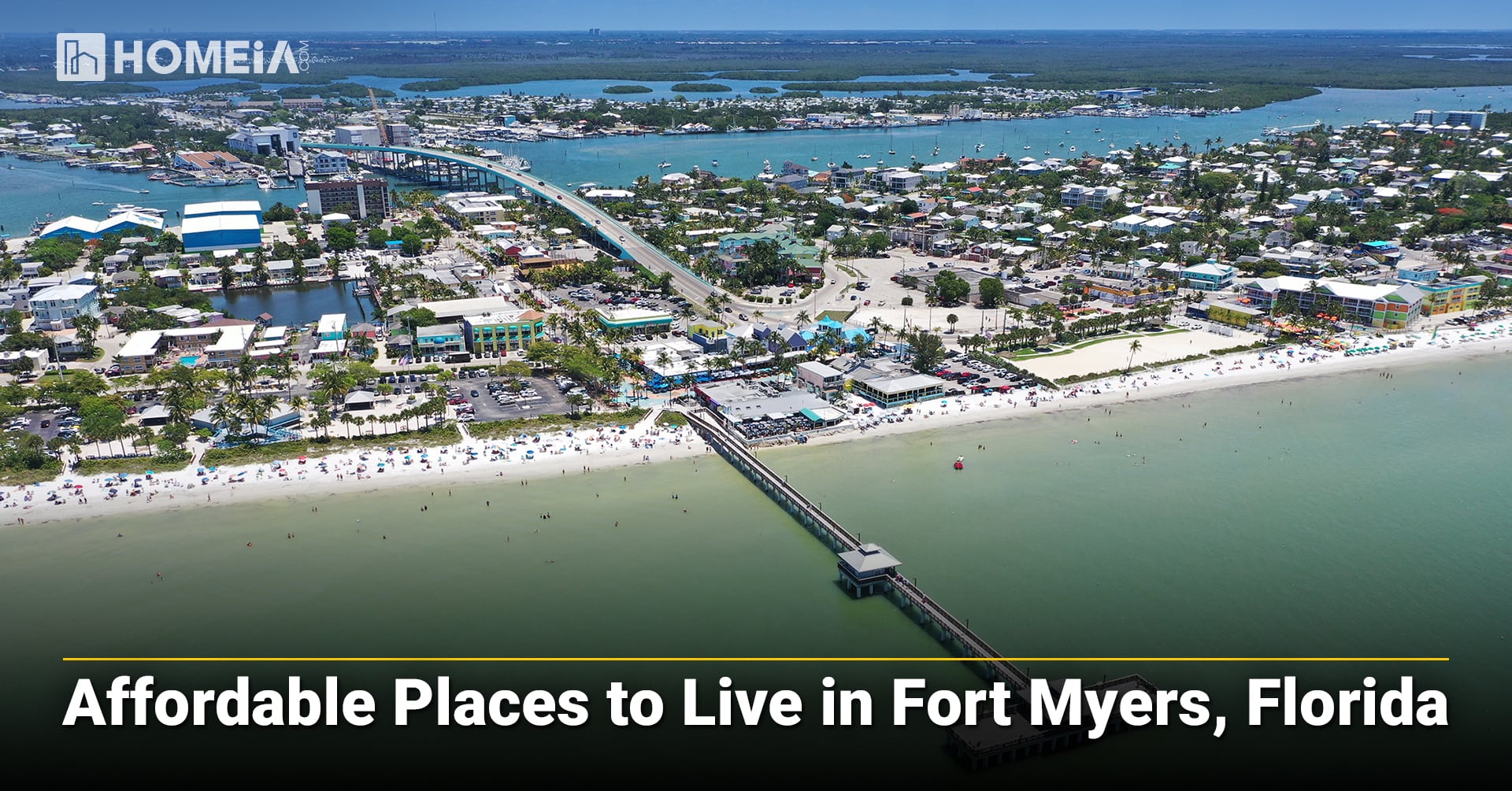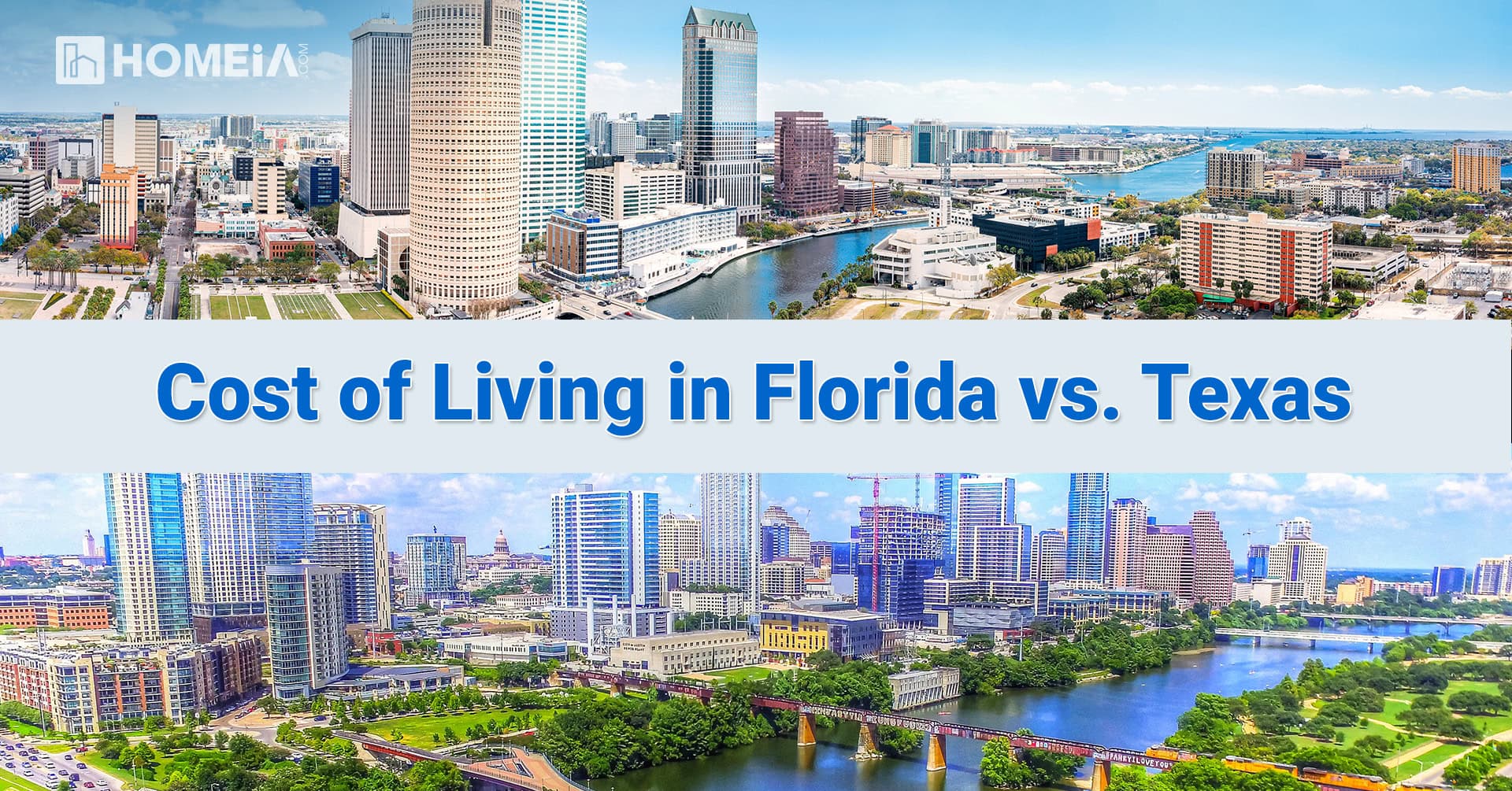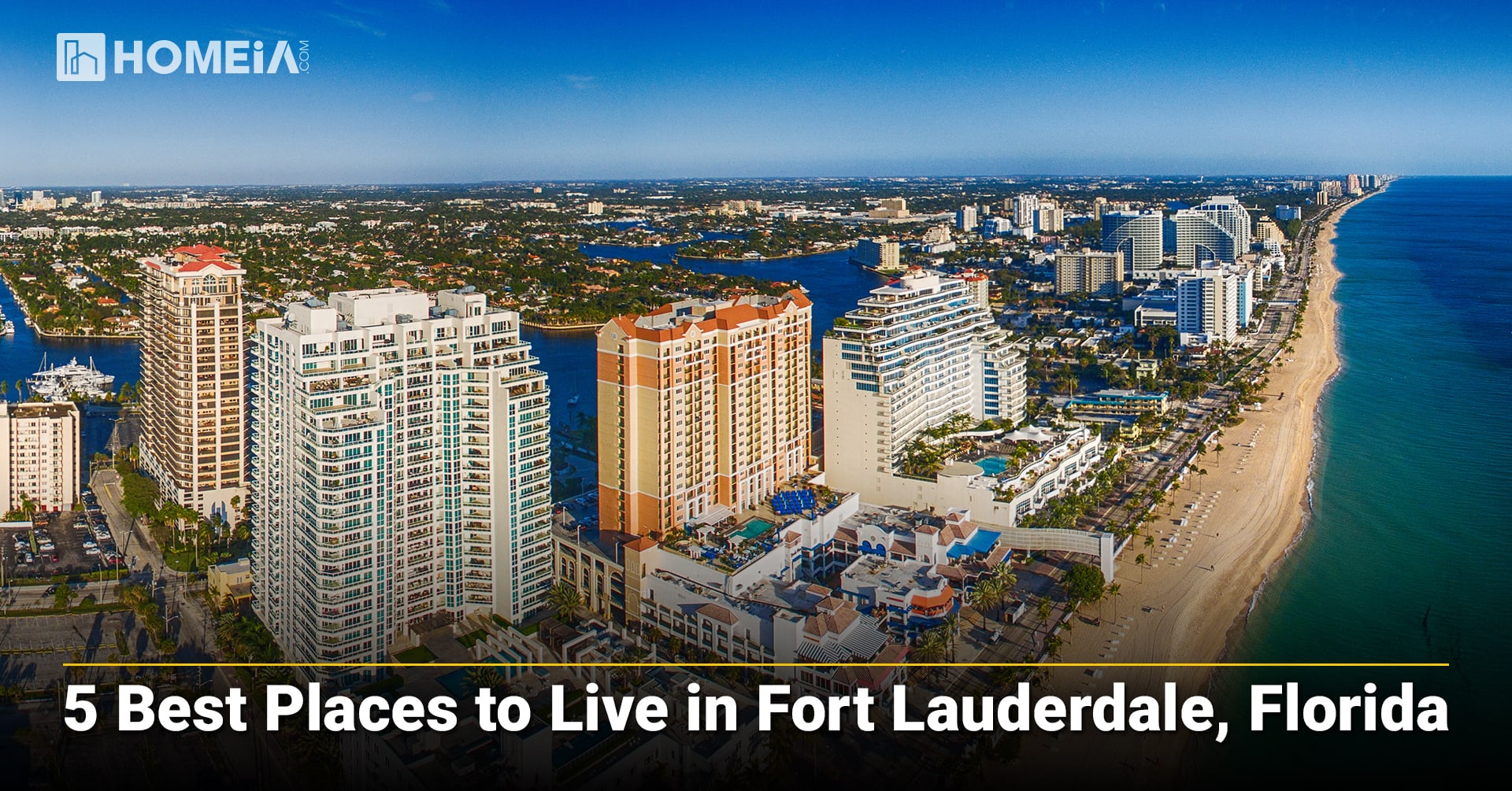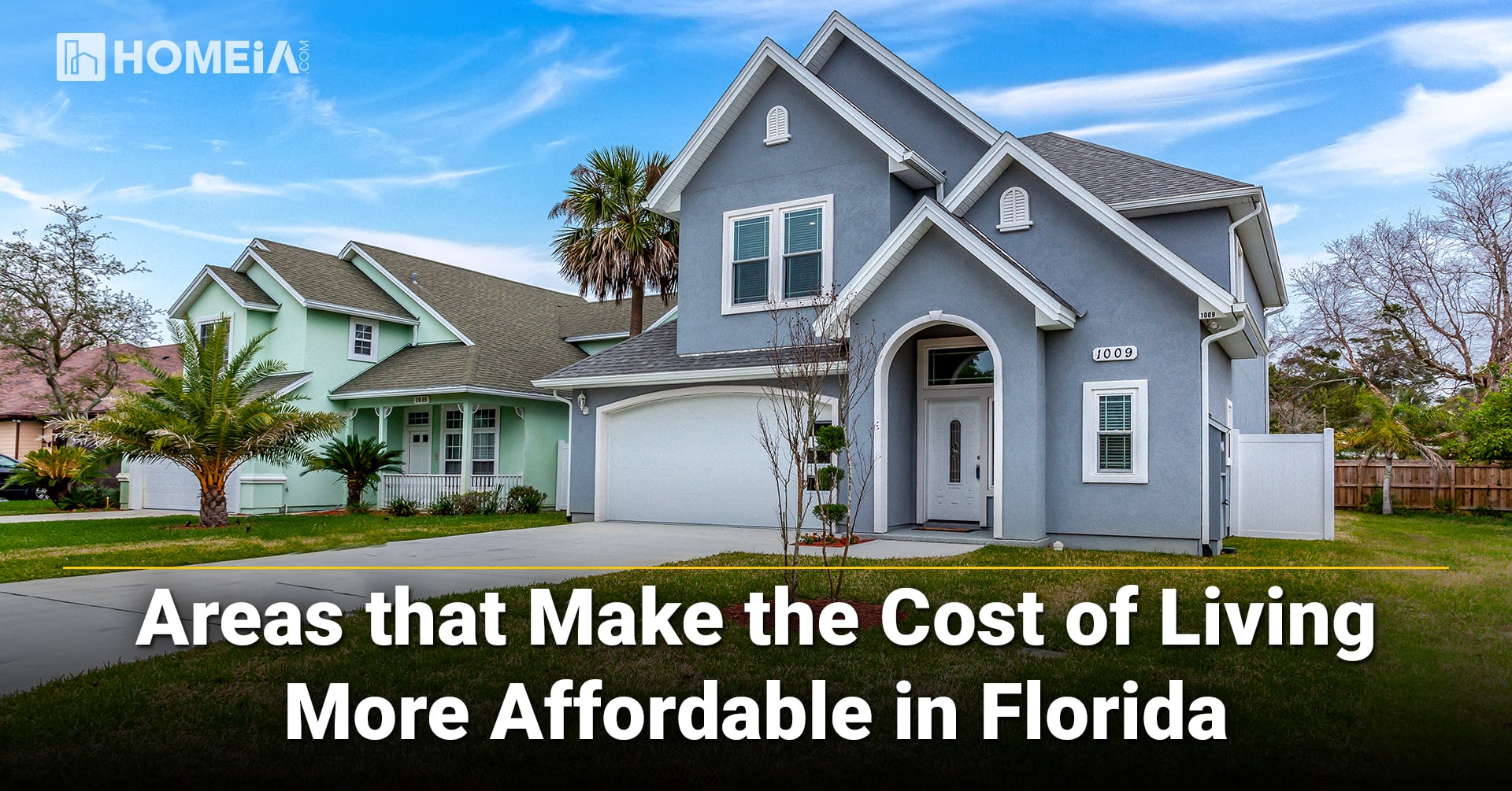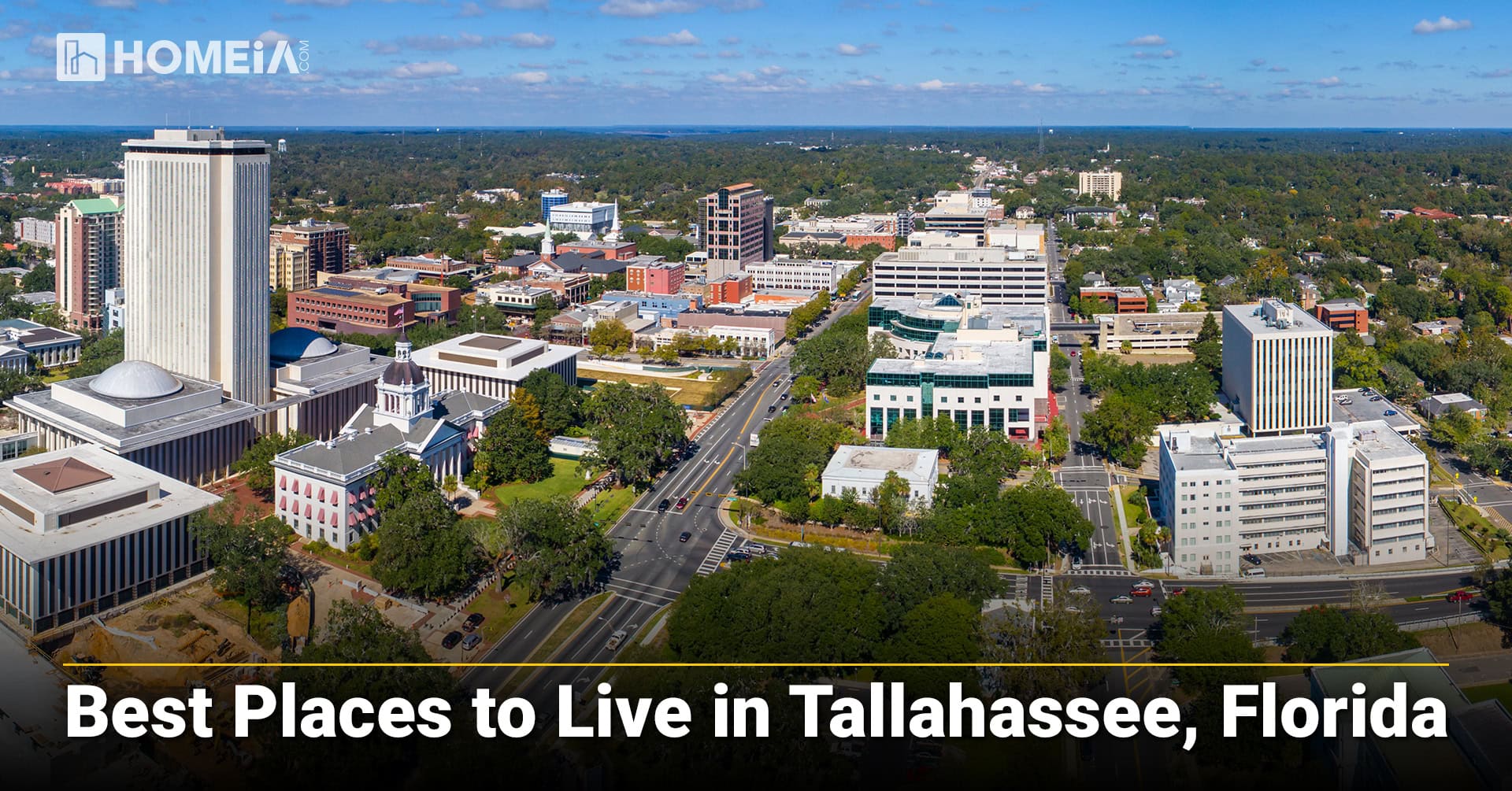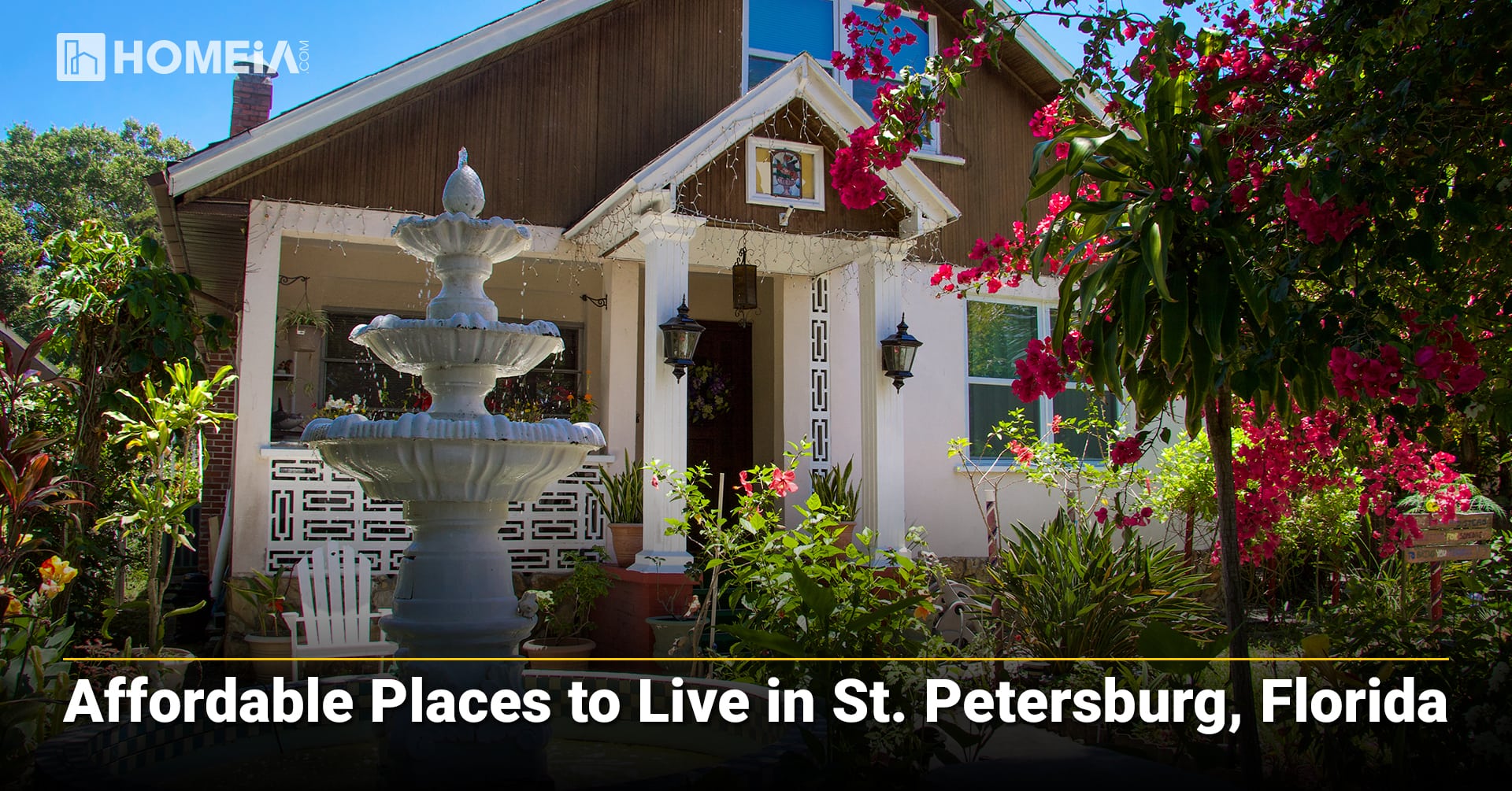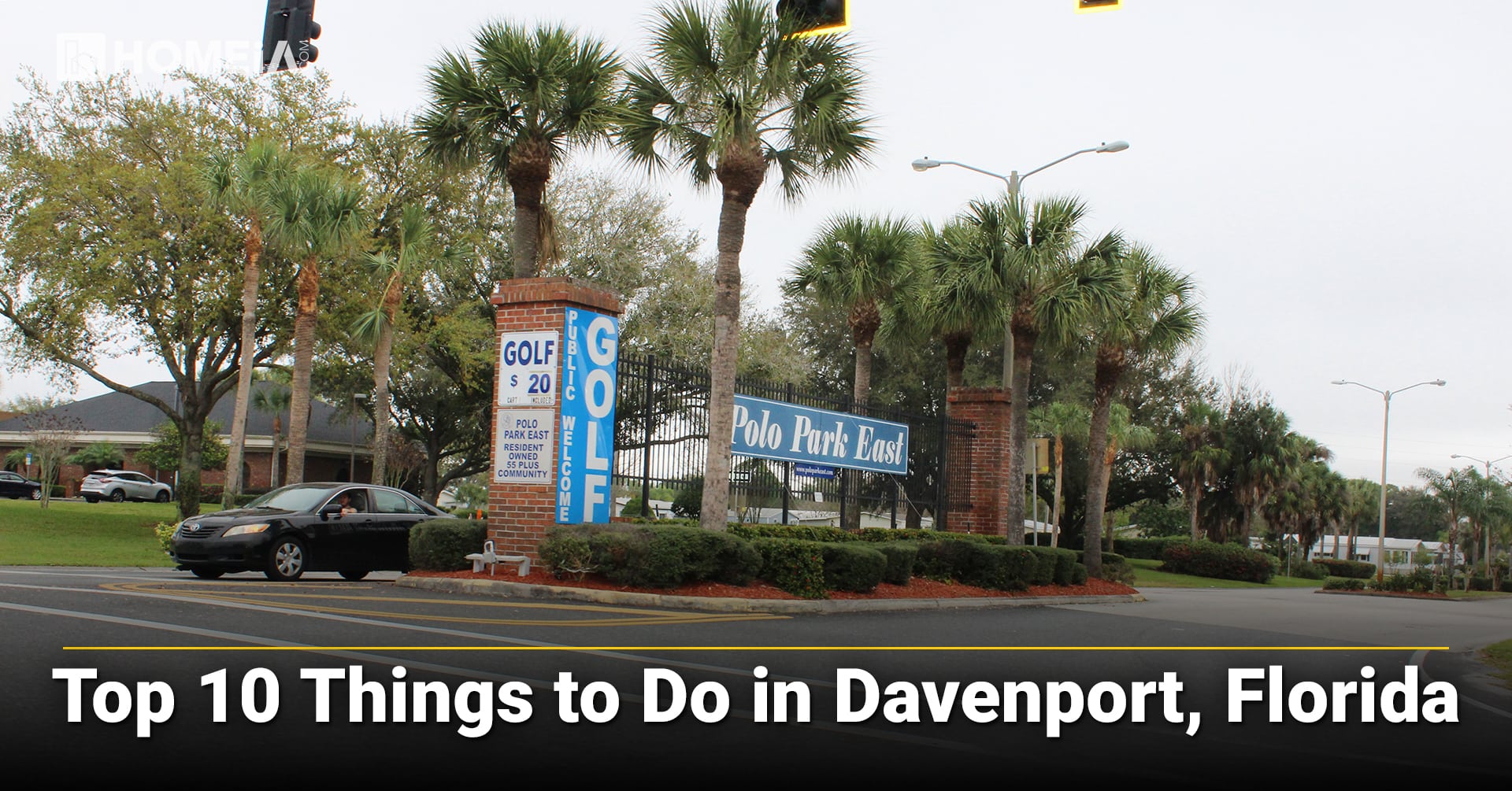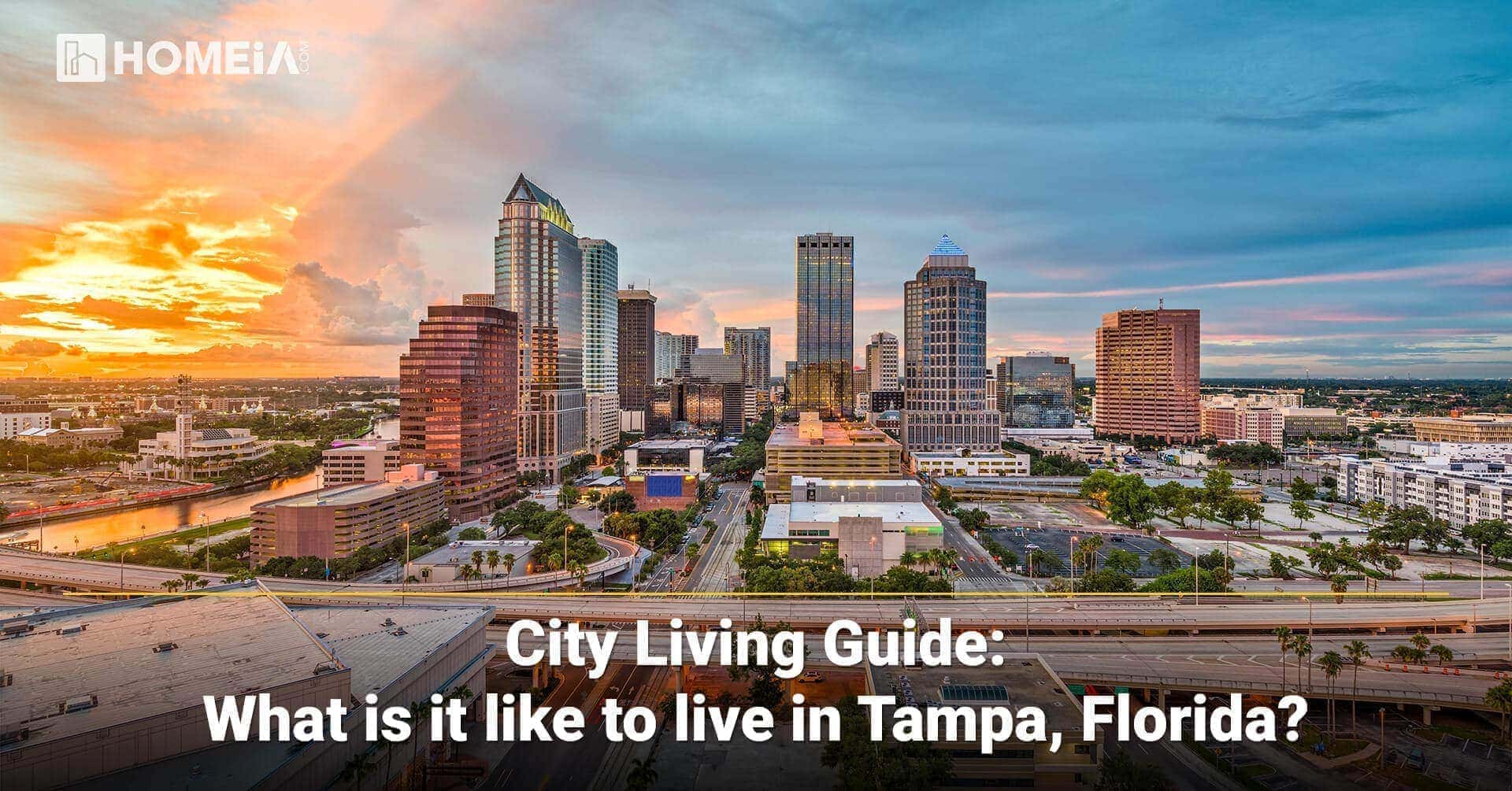Living in Florida
Local Editor(s)
Table of Contents:
- The Complete Guide to Cost of Living and Lifestyle
- 1. Florida’s Housing Costs: From Coastal Luxury to Inland Value
- 2. Florida’s Tax Structure: The Zero Percent Advantage
- 3. Florida’s Daily Living Expenses
- 4. Florida’s Family Life: Educational Excellence and Affordability
- 5. Florida’s Transportation: A Car Culture with Growing Alternatives
- 6. Florida’s Job Market and Income Potential
- 7. Florida’s Cost of Living Comparison: In the Mix
- 8. Florida’s Lifestyle: Year-Round Outdoor Paradise
- 9. Florida’s Best Places to Live for Your Situation
- Frequently Asked Questions About Living in Florida
The Complete Guide to Cost of Living and Lifestyle
Florida living offers an exceptional combination of sunshine, affordability, and lifestyle diversity that attracts nearly 1,000 new residents to the Sunshine State each day (you read that correctly – every day). Known for having zero state income tax, combined with booming job markets and year-round access to beaches and entertainment, Florida draws families, retirees, and professionals from across the nation and around the world. This comprehensive Florida cost of living guide outlines housing costs, taxes, daily expenses, educational offerings, transportation networks, job opportunities, and lifestyle options to help you determine whether Florida is the perfect home for your life’s next chapter. So let’s dig in!
1. Florida’s Housing Costs: From Coastal Luxury to Inland Value

Florida real estate literally spans the spectrum, from luxury beachfront condos and showpiece estates in Miami and Naples to affordable inland family homes in Central and North Florida. Understanding the dynamics of Florida’s housing market in a state that actually feels like several states rolled into one helps potential residents find the best value for their budget and lifestyle preferences.
A. Major Market Housing Costs
| Market | Median Home Price | 2-Bedroom Rent | 3-Bedroom Rent | HOA Fees |
|---|---|---|---|---|
| Miami | $570,000 | $2,600/month | $3,400/month | $200-$500/month |
| Orlando | $400,000 | $2,000/month | $2,800/month | $150-$400/month |
| Tampa | $420,000 | $2,100/month | $2,900/month | $100-$300/month |
| Jacksonville | $360,000 | $1,800/month | $2,600/month | $80-$200/month |
| Ocala | $280,000 | $1,400/month | $2,000/month | $50-$150/month |
Coastal cities like Miami, Fort Lauderdale, and Naples will always command premium prices due to proximity to beaches, international business centers, and luxury amenities. Inland markets, however, offer exceptional value, with areas like Ocala, Lakeland, and Gainesville providing affordable housing and square footage you may be used to in your current home without sacrificing quality of life.
B. Housing Incentives and Financial Strategies
Florida supports homeownership through innovative programs like Florida Hometown Heroes, which offers down payment assistance up to $35,000 from state funds specifically for essential workers including teachers, healthcare professionals, and first responders. This program, which evolved in 2025 to reflect higher income limits and a streamlined application process, recognizes the vital contributions of community servants by making homeownership more accessible.
VA, FHA, and USDA loans are widely available throughout Florida, with many lenders specializing in these government-backed programs. The Florida Homestead Exemption provides an exemption up to the first $50,000 of the assessed value of a home, resulting in significant property tax savings for primary residents and savings of thousands of dollars annually on their tax bills.
Smart homebuyers often consider suburban communities outside major metros such as Winter Garden near Orlando, Riverview near Tampa, or Fleming Island near Jacksonville for even more space and better value. These communities typically offer newer construction, family-friendly amenities, and excellent public, private and charter schools while maintaining reasonable commute times to urban employment centers.
Abundant new construction in Central and North Florida regions continues expanding rapidly, offering energy-efficient homes with modern amenities and competitive pricing. Developers are creating master-planned communities with resort-style amenities, walking trails, and community centers that enhance quality of life for residents. The good news? Supply is plentiful and you’ll have plenty of options in these areas – and lots of new neighbors soon!
2. Florida’s Tax Structure: The Zero Percent Advantage
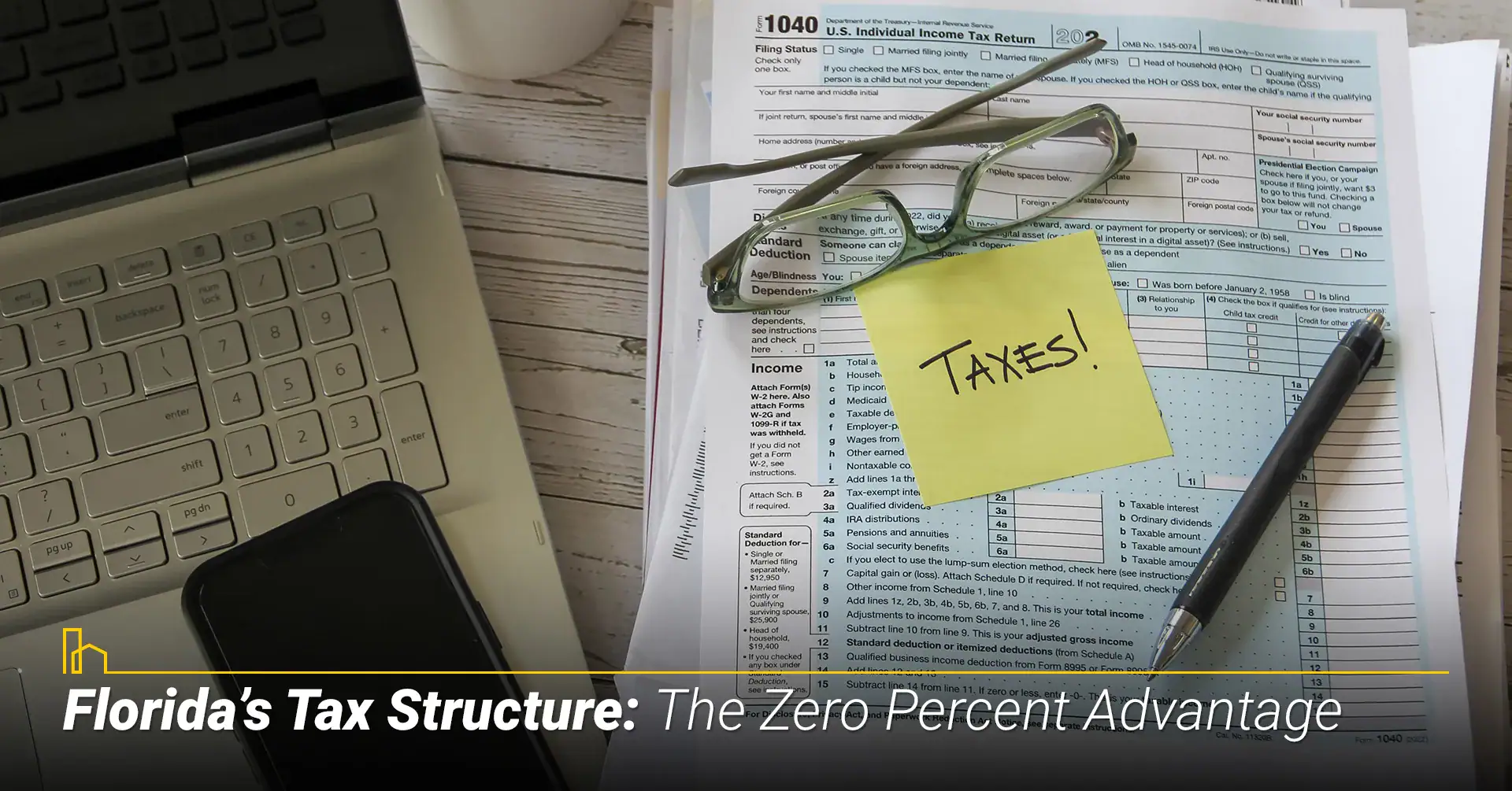
Florida’s tax structure represents an amazing advantage for residents, particularly those moving from high-tax states seeking to maximize their income potential and feel more money in their take-home pay.
A. State Tax Overview
| Tax Type | Florida Rate | Key Benefits |
|---|---|---|
| Income Tax | 0% | No state income tax, regardless of income |
| Sales Tax (Base) | 6% | Local additions bring average to 7% |
| Property Tax | ~0.80% | Homestead exemption available (up to $50k) |
| Gas Tax | $0.36/gallon | Funds transportation infrastructure |
| Inheritance Tax | 0% | No estate or inheritance taxes |
| Retirement Income | Tax-free | Social Security and pensions are untaxed |
Florida’s state constitution bans state income tax, allowing residents to keep more of their paycheck compared to most other states. This advantage particularly benefits high-income earners, retirees living on fixed incomes, and remote workers who can maintain salaries from higher-tax states while enjoying Florida’s tax benefits. So how can Florida thrive without state income tax collection? Mainly from sales tax, which contributes to 79% of Florida’s revenue. Property tax and highway tolls comprise much of the rest.
Property taxes remain moderate at approximately 0.80% of assessed value, especially when factoring in the state’s homestead exemption that can reduce taxable value by up to $50,000 for primary residences. This exemption provides substantial savings for residents who establish Florida as their permanent home.
B. Tax Comparison: Florida vs Other States
| Tax Type | Florida | New York | Arizona | California |
|---|---|---|---|---|
| Income Tax | 0% | Up to 10.9% | 2.5% | Up to 13.3% |
| Sales Tax Avg. | 7.0% | Up to 8.8% | 8.4% | 8.82% |
| Property Tax | 0.80% | 1.54% | 0.66% | 0.71% |
| Gas Tax | $0.36/gallon | Up to $0.50/gallon | Varies | Highest in nation |
Florida’s tax advantages become even more apparent when compared to high-tax states like California, where residents can face combined state and local tax rates exceeding 13%. For a household earning $100,000 annually, the tax savings from moving to Florida from a higher-tax state could exceed $8,000-12,000 per year.
3. Florida’s Daily Living Expenses
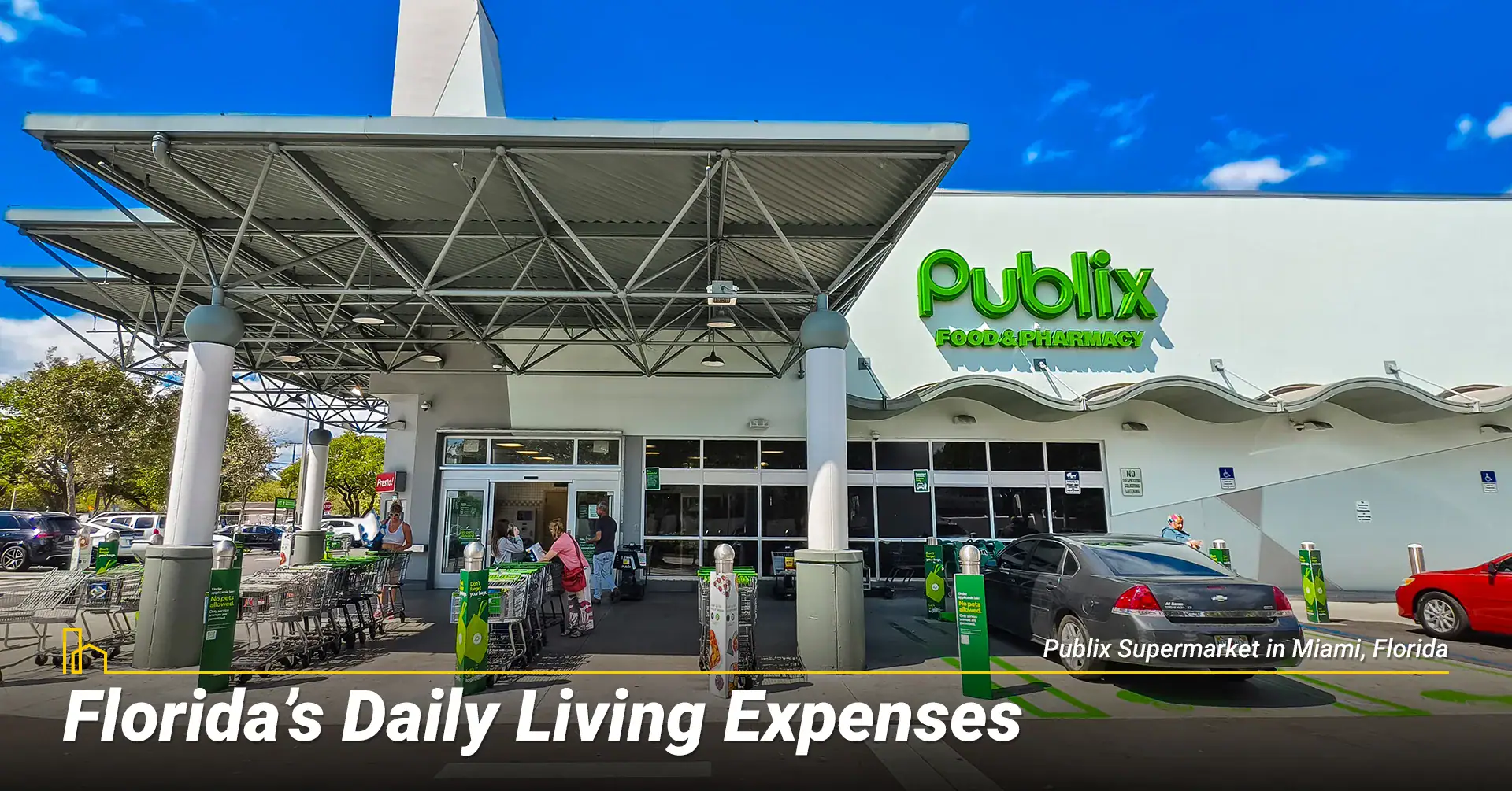
The cost of daily living in Florida generally aligns with national averages, though some categories vary based on location and seasonal factors that affect utility and insurance costs.
A. Monthly Living Costs
| Expense Category | Florida’s Cost | National Comparison | Regional Variations |
|---|---|---|---|
| Groceries (per person) | $300-$450/month | On par with national average | Higher in Miami/the Florida Keys |
| Utilities | $180-$250/month | Slightly above average | Peak in summer months |
| Gasoline | $3.20/gallon | Near national average | Lower than West Coast |
| Healthcare (individual) | $450-$600/month | Slightly above average | Higher quality in urban areas |
| Dining Out | $15-$25/meal | Competitive pricing | Higher prices in Miami, Naples |
Florida’s grocery costs remain competitive with national averages, though coastal and tourist areas predictably see higher prices. The state’s lack of state income tax helps offset slightly higher utility costs during summer cooling seasons, although many residents will tell you they keep their air conditioning on year-round anyway.
B. Cost-Saving Strategies
Cost-conscious Sunshine State residents find competitive prices and grocery savings at popular chains like Publix (the state’s supermarket flagship, with more than 900 stores, known for its excellent customer service and frequent sales), Aldi (offering European-style discount pricing on off-brands), and Walmart (providing consistent low prices and price matching). Farmers markets and roadside stands throughout the state provide access to fresh, local produce often at prices below traditional grocery stores. Just remember to bring cash!
Electricity usage spikes significantly during Florida’s summer months, typically from May through September. Investing in efficient HVAC systems, programmable thermostats, ceiling fans, solar options, and blackout curtains can reduce cooling costs by 20-30%. Many utility companies offer rebates for energy-efficient upgrades and time-of-use pricing that rewards off-peak consumption.
Healthcare costs can be managed through flexible savings accounts via employers, telehealth services, health co-ops, and community wellness clinics that provide preventive care at reduced costs. Florida’s large retiree population, greater than 4 million residents and nearly 18% of the state’s headcount, has created a robust healthcare infrastructure with competitive pricing in many markets.
4. Florida’s Family Life: Educational Excellence and Affordability
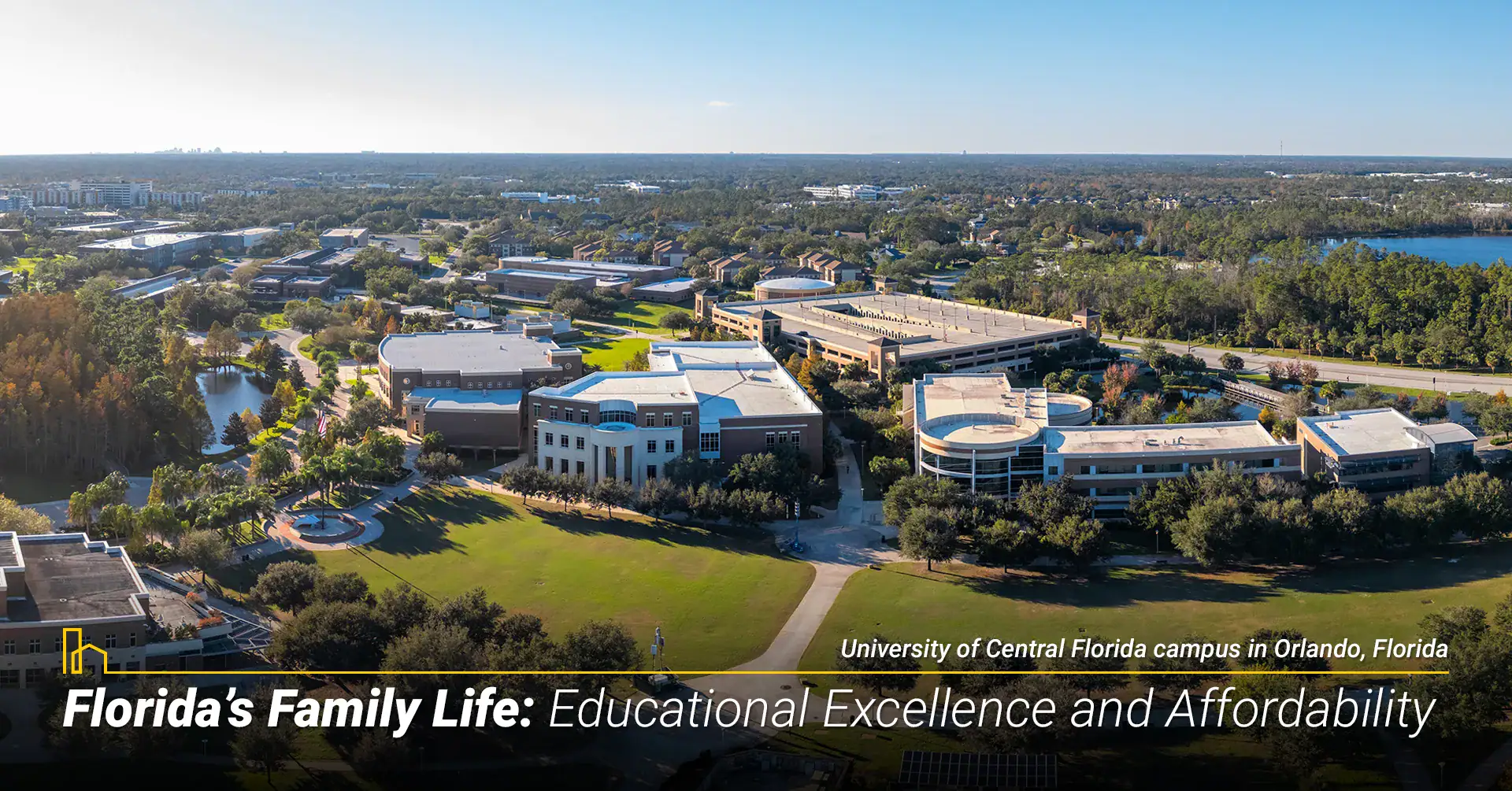
Florida offers an outstanding and high-quality family life with top-rated public school districts, nationally noted private and charter schools, affordable childcare options, and year-round recreational and relaxation opportunities that support active, healthy lifestyles for children and parents.
A. Educational Excellence
As part of the nation’s top-ranked educational system, Florida’s notable public school districts include St. Johns County (consistently ranked among the nation’s best), Sarasota County (known for innovative programs), and Seminole County (offering excellent STEM education). These districts benefit from Florida’s commitment to educational funding and school choice initiatives.
Florida’s Bright Futures scholarship program, funded through Florida Lottery proceeds, provides merit-based financial aid that can cover significant portions of in-state college tuition, making higher education more accessible for Florida high school graduates. This program has helped more than 1 million Florida students attend college without crushing debt burdens.
The state features exceptional charter and magnet schools with particular focus on the arts and STEM/STEAM education, as well as bilingual immersion programs and numerous private and parochial school options that cater to diverse educational philosophies and learning styles. International Baccalaureate programs, country-specific academies, and trade-focused schools provide specialized education opportunities.
The University of Florida, Florida State University, University of South Florida and University of Central Florida offer world-class higher education at in-state tuition rates that represent tremendous value compared to private institutions or out-of-state alternatives. Thanks to an extensive and high-quality state college (formerly community college) system, including the nation’s largest, Miami Dade College, affordable regional access to higher education throughout the state is within reach.
B. Family Living Expenses and Activities
| Family Expense | Florida Cost | Available Options | Money-Saving Tips |
|---|---|---|---|
| Childcare | $800-$1,200/month | Daycare, family care, nannies | Employer assistance programs |
| Youth Sports | $150-$500/season | Community leagues, school teams | Public recreation departments |
| After-School Care | $200-$500/month | School-based, private programs | YMCA, community centers |
| Summer Camps | $100-$300/week | Day camps, specialty programs | Early registration discounts |
Florida’s year-round warm weather creates endless opportunities for family activities including beach visits, exploring national, state and county parks, hiking, biking, and water sports. Many of these activities are free or low-cost, helping families maintain active lifestyles without expensive entertainment budgets. Public beach access statewide is free, for example, unlike states such as New Jersey that require paid permits.
5. Florida’s Transportation: A Car Culture with Growing Alternatives
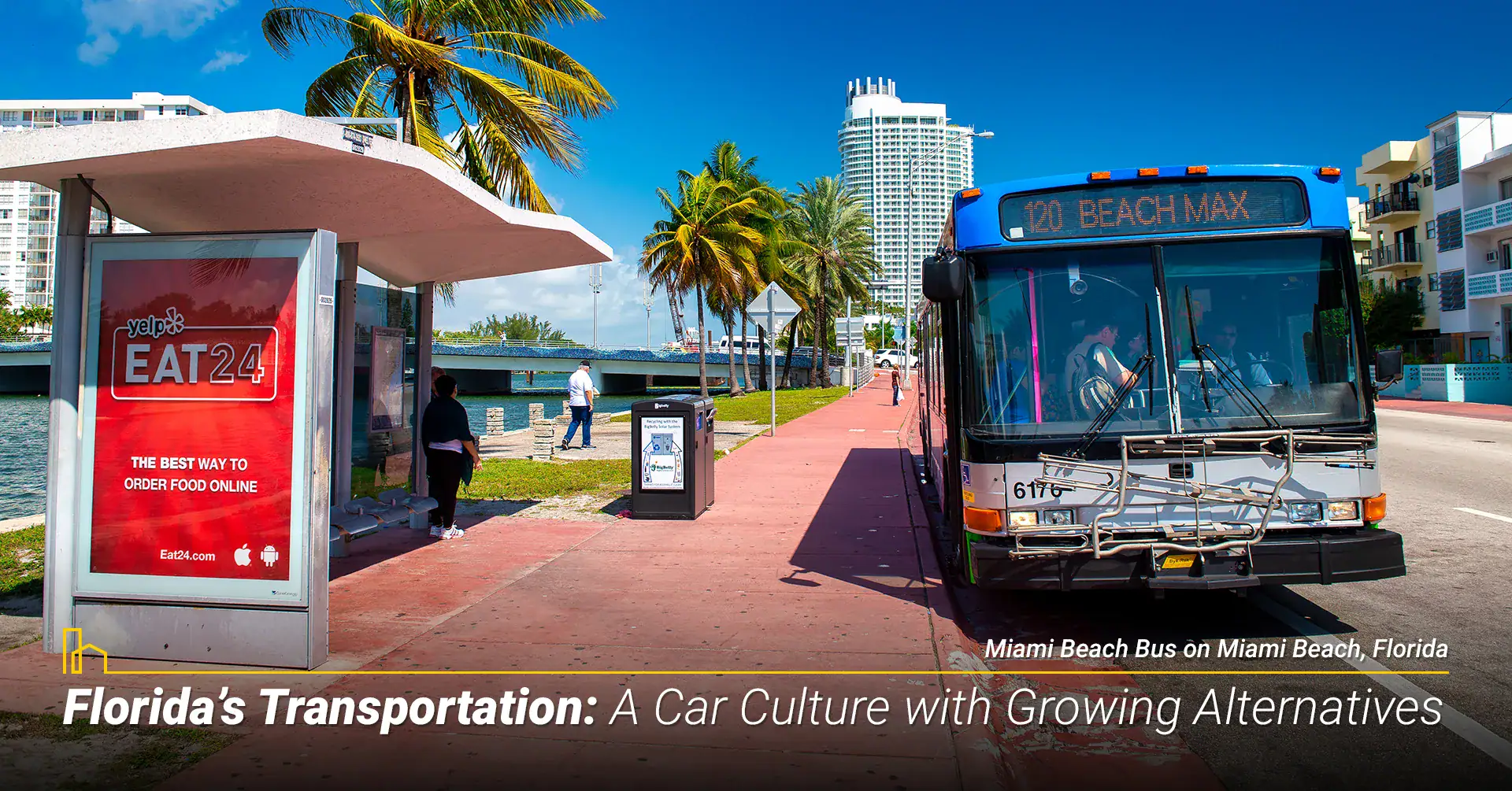
Florida’s transportation landscape has historically centered around personal vehicle ownership, though public transit options are expanding in major metropolitan areas to serve growing populations.
A. Vehicle-Related Expenses
| Cost Category | Florida Average | National Comparison | Cost Factors |
|---|---|---|---|
| Auto Insurance | ~$2,200/year | Higher than average | Hurricane risk, tourist traffic |
| Gas | ~$3.20/gallon | Near national average | Gulf Coast refineries |
| Vehicle Registration | $225-$275/year | Moderate fees | No annual inspections |
| Maintenance | Standard rates | Competitive markets | Salt air affects coastal areas |
Florida has average commute times of 30 minutes in major cities, which compares favorably to many metropolitan areas nationwide, although many factors can dictate commute time. Most daily commuters rely upon their own cars, so personal vehicle ownership remains essential outside of dense downtown cores in Miami, Tampa, and St. Petersburg.
Auto insurance costs typically run much higher than national averages due to factors including hurricane risk, heavy tourist traffic, and higher rates of uninsured drivers. Shopping among multiple providers and maintaining good driving records can help manage these costs, but this cost category is immediately noticeable.
B. Public Transit and Alternative Transportation
| Metro Area | Transit System | Monthly Pass | Daily Fare | Coverage |
|---|---|---|---|---|
| Miami | Metrorail, Metrobus | $112 | $2.25 | Comprehensive urban coverage |
| Orlando | LYNX | $50 | $2.00 | Growing system, airport connections |
| Tampa | HART | $65 | $2.00 | Regional routes, express services |
| Jacksonville | JTA | $65 | $1.50 | Bus system, limited rail |
Miami’s Metrorail system provides the most comprehensive public transit in Florida, connecting downtown with a limited number of suburban areas and Miami International Airport. Orlando’s LYNX system continues expanding to serve theme park areas and growing suburban communities.
Bike and scooter sharing programs are increasingly available in walkable areas like downtown St. Petersburg, Miami Beach, Fort Lauderdale, Miami, and parts of Orlando, providing residents and tourists with convenient short-distance transportation options. The Brightline high-speed rail service now travels several times per day between Miami and Orlando, with stops in Boca Raton, Fort Lauderdale and Aventura.
6. Florida’s Job Market and Income Potential

Due mostly in part to the state’s ever-expanding population, Florida’s job market demonstrates consistent growth across multiple sectors, driven by business-friendly policies, international investment, and strategic industry development initiatives.
A. Income Statistics and Employment Trends
| Income Metric | Florida | National Average | Growth Outlook |
|---|---|---|---|
| Minimum Wage | $12/hr (increases to $15/hr by 2026) | $7.25/hour federal | Gradual increases planned |
| Median Household Income | ~$65,000/year | $70,000/year | Steady growth expected |
| Unemployment Rate | 3.1% | Varies by region | One of lowest in America |
| Job Growth Rate | Above national average | Varies | Strong in most sectors |
B. Major Industries and High-Growth Sectors
| Industry | Key Companies | Typical Salary Range | Growth Outlook |
|---|---|---|---|
| Aerospace/Defense | Lockheed Martin, Boeing | $65,000-$130,000 | Strong government contracts |
| Tourism/Hospitality | Disney, Universal, Marriott, Royal Caribbean | $35,000-$85,000 | Consistent demand |
| Technology | Microsoft, IBM, startups | $60,000-$140,000 | Rapidly expanding |
| Healthcare | HCA, Baptist Health, Mayo Clinic, Advent Health | $45,000-$150,000 | Growing with aging population |
| Logistics/Trade | Port of Miami, FedEx, Amazon | $40,000-$90,000 | International trade growth |
Industries like aerospace, tourism and hospitality, logistics, and healthcare dominate Florida’s employment landscape. Tampa and Miami are emerging as significant financial services and tech hubs, attracting companies seeking talented workforces and business-friendly environments. Orlando leads in hospitality and theme park management, creating opportunities across multiple skill levels.
Florida’s pro-business tax structure, favorable regulatory environment, and year-round operating weather continue attracting corporate relocations and remote workers seeking lifestyle improvements without career sacrifices. Miami’s growing posture as a gateway to the Americas ensures plenty of Latin-American corporate investment and relocation as well.
7. Florida’s Cost of Living Comparison: In the Mix
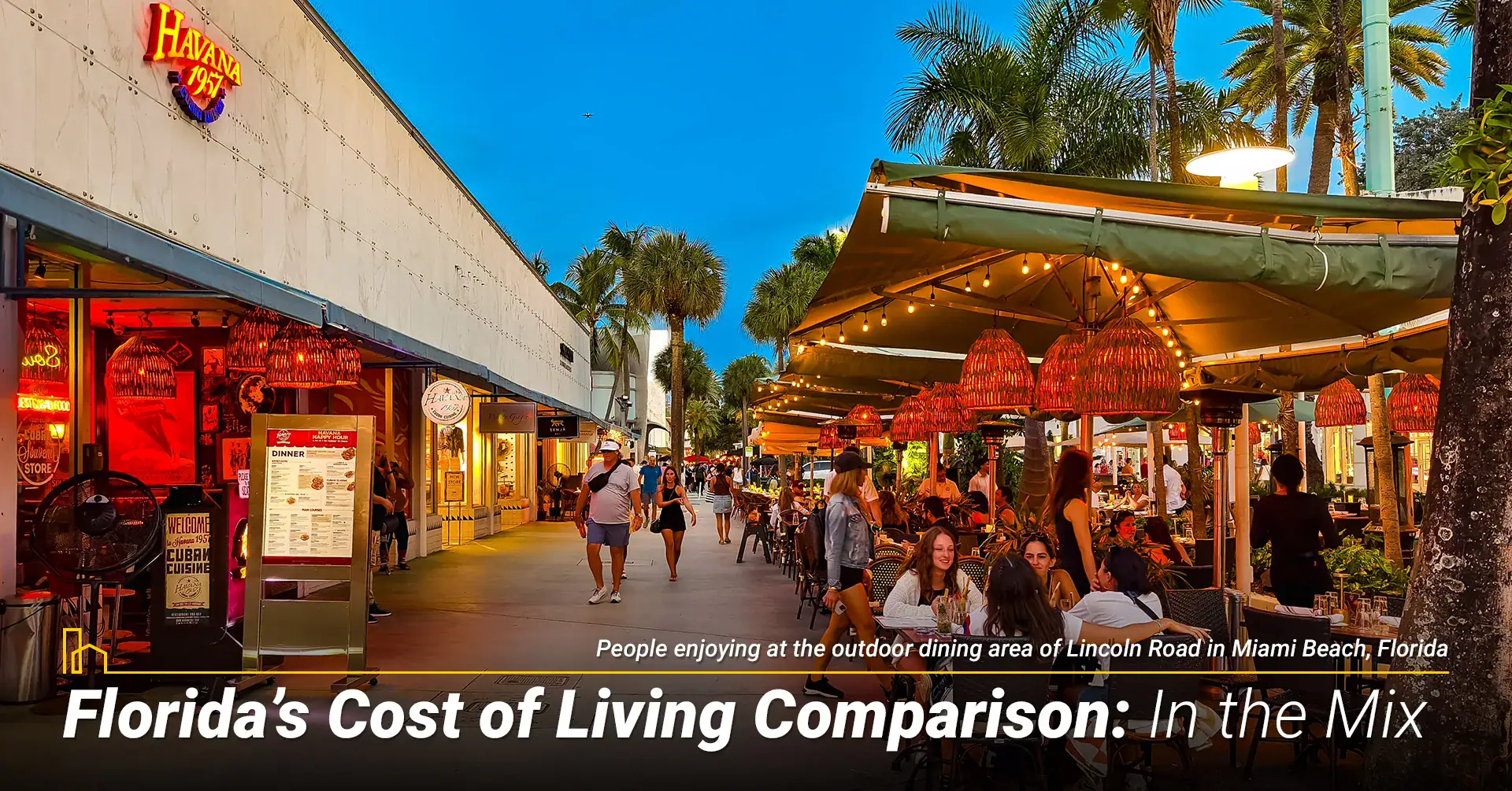
Florida competes effectively with other popular relocation destinations, offering unique advantages that appeal to different demographics and lifestyle preferences.
| Category | Florida | New York | Arizona | California |
|---|---|---|---|---|
| Income Tax | 0% | Up to 10.9% | 2.5% | Up to 13.3% |
| Sales Tax (avg) | 7.0% | 8.88% | 8.4% | 8.82% |
| Median Home Price | $390,000 | $885,000 | $435,000 | $743,000 |
| Gas Price | $3.20 | $3.60 | $4.15 | $5.15 |
| Property Tax | ~0.80% | ~1.23% | ~0.66% | ~0.71% |
| Hurricane Insurance | Required | Not applicable | Not applicable | Earthquake risk |
Among this comparison group, Florida leads in tax advantages as one of just nine states nationwide with no state income tax, while California and New York remain the most expensive across nearly all categories. Arizona offers similar climate benefits but with higher housing costs in desirable areas and less water access for recreation.
8. Florida’s Lifestyle: Year-Round Outdoor Paradise
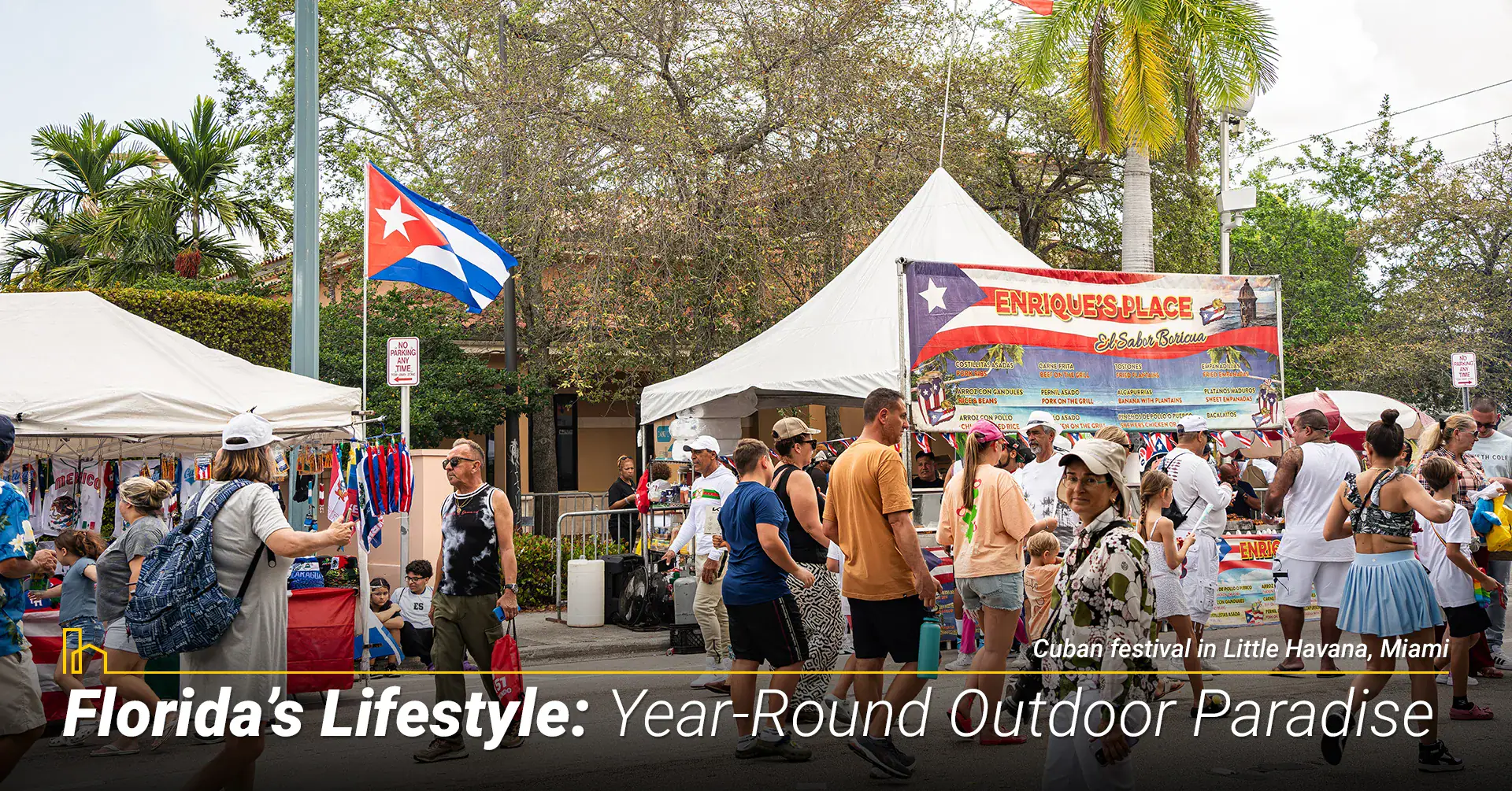
Let’s repeat what you already know and what has you reading this far: Florida’s year-round warm weather and tropical climate supports a lifestyle centered around outdoor recreation, entertainment, and community engagement that enhances quality of life for residents of all ages.
A. Outdoor Recreation and Natural Beauty
Florida’s coastline stretches over 1,300 miles across the Gulf and Atlantic sides of the state, promising swimming, boating, fishing, surfing, sunbathing and other beach activities year-round. The state features diverse ecosystems from the Everglades wetlands to crystal-clear springs, barrier islands, inlets, and tropical keys that provide endless exploration opportunities.
Parks, boardwalks, golf courses, and biking trails abound throughout the state. In addition to noted national parks featuring the Everglades, the Florida State Parks system includes more than 175 parks protecting natural and cultural resources while providing affordable recreation for families. Many parks offer camping, hiking, kayaking, and educational programs that connect residents with Florida’s unique environment.
B. Cultural Life and Entertainment
Florida’s diverse and international population has led to a thriving arts, culture and entertainment scene which thrives across Florida’s diverse regions. Miami’s Art Deco District and Wynwood Design District murals create eclectic urban experiences, while St. Augustine’s historic sites offer glimpses into America’s oldest continuously inhabited city. Tampa’s Gasparilla Festival, Key West’s Fantasy Fest, and countless local festivals blend culture with community fun every week of the year.
Major theme parks including Walt Disney World, Universal Studios, MGM, Busch Gardens, and SeaWorld attract millions of visitors and more than $130 billion in economic impact annually, while providing year-round employment opportunities for residents. Because of so much out-of-state revenue, these attractions also offer residents discounted admission and seasonal passes that make entertainment more affordable.
The wellness scene flourishes with beach yoga, holistic health clinics, farmers markets, and outdoor fitness opportunities woven into daily life. Florida’s emphasis on outdoor and healthy living supports active aging and family wellness.
9. Florida’s Best Places to Live for Your Situation

Florida’s diversity offers cities and communities suited for various lifestyles, budgets, and priorities, making it possible for almost anyone to find their ideal Sunshine State spot.
A. Family-Friendly Communities
| You’re Looking For… | Best Communities | Median Home Price | Key Benefits |
|---|---|---|---|
| Suburban Families | Weston, Oviedo, Palm Harbor, Celebration | $450,000-$550,000 | Top schools, safety, amenities |
| Affordable Families | Ocala, Lakeland, Pensacola, Sebastian | $280,000-$350,000 | Lower costs, good schools |
| Coastal Families | Sarasota, Stuart, Neptune Beach, Vero Beach | $500,000-$700,000 | Beach access, excellent schools |
B. Professional and Retiree Options
Young professionals gravitate toward Tampa, Orlando, and Miami for booming job markets, vibrant nightlife, and urban walkability. These cities offer endless career advancement opportunities, cultural attractions, and diverse dining and entertainment options.
Retirees often choose The Villages, Venice, Vero Beach, and Naples for active adult communities, comprehensive healthcare access, and favorable tax treatment of retirement income. These communities frequently feature golf courses, social clubs, and age-restricted housing designed for active aging.
Nature lovers find paradise in Gainesville, Sarasota, the Florida Keys, and St. Augustine, where access to parks, springs, wildlife refuges, and outdoor recreation opportunities abound. These areas offer a more relaxed pace while maintaining access to cultural amenities and healthcare services.
Conclusion: Making Florida Living Work for You
Florida continues attracting new residents each day, and the state’s 24 million residents take advantage of a compelling blend of economic opportunity, tax advantages, and laid-back lifestyle that appeals to diverse demographics. Whether you’re relocating to the Sunshine State for career advancement, retirement planning, or simply seeking a better climate, you’ll find abundant choices for creating your ideal lifestyle in Florida.
The state’s strong and growing job markets, affordable inland communities, and outdoor-based culture make it an easy-to-adopt destination for families, professionals, and retirees. With no state income tax and lower property tax rates than many states, your income stretches further in Florida while you maintain access to some of the nation’s top-ranked healthcare, education, and recreation amenities
While planning for insurance costs and climate considerations is important, for most residents the advantages of Florida living far outweigh the challenges, creating a foundation for long-term happiness and prosperity.
Frequently Asked Questions About Living in Florida
1. Is Florida a good place to retire financially?
Perhaps the best place! Florida offers significant tax advantages including no state income tax, no inheritance tax, and homestead exemptions that can drastically reduce property taxes. Combined with excellent healthcare access and active retirement communities, Florida provides outstanding value for those looking to enjoy their golden years.
2. How expensive is homeowner’s insurance in Florida?
Home insurance costs more than the national average due to hurricane risks, typically ranging from $1,500-$4,000 annually depending on location and coverage. Coastal areas and mobile homes face higher premiums, while inland areas with newer construction and more protection from hurricanes often see lower rates.
3. Do Florida residents pay any state income tax?
No, Florida is one of nine states with no state income tax on wages, salaries, or retirement income. This applies to Social Security benefits, pensions, and investment income, making Florida particularly attractive for retirees and high net worth individuals.
4. Is Florida affordable for families with children?
Yes, especially in suburban inland cities with good public or charter school districts. Areas like Ocala, Lakeland, Parkland, Sebastian and parts of Jacksonville offer affordable housing, quality education, and family-friendly amenities while maintaining reasonable commute access to employment centers.
5. What are the main drawbacks of living in Florida?
Summer humidity and heat can be challenging and exhausting, hurricane season requires preparation and insurance, and some areas experience heavy tourist traffic, especially “in season” (November-April). Additionally, home insurance costs are higher than most states due to weather risks.
6. Is Florida suitable for remote work and digital nomads?
Yes, Florida offers excellent internet infrastructure, no state income tax advantages, co-working spaces in all major cities, and year-round outdoor recreation opportunities. Many remote workers appreciate the lifestyle benefits and tax savings.
7. Which Florida cities have the best public school systems?
St. Johns County, Sarasota County, and Seminole County consistently rank among Florida’s top school districts. These areas offer excellent STEM, arts and pre-professional programs, advanced placement courses, and high graduation rates with strong college placement records.
8. How reliable is public transportation in Florida?
Public transit is extremely limited outside major downtown areas. Miami offers the most comprehensive system with Metrorail and Metrobus, while Orlando and Tampa have growing networks. Most residents rely on personal vehicles for daily transportation needs, contributing to an average home-to-work commute time of 30 minutes statewide.
9. How does Florida’s cost of living compare to California?
Florida is significantly cheaper than California across most categories. Housing costs are 40-50% lower, there’s no state income tax versus California’s high rates, and daily expenses like gas and groceries typically cost less while offering similar climate benefits.
10. Can you enjoy outdoor activities year-round in Florida?
Absolutely. Florida’s subtropical climate enables beach activities, hiking, biking, boating, tennis and golf throughout the year. While summers can be hot and humid, most outdoor activities remain viable with proper timing and hydration, making Florida ideal for active lifestyles.
Local Editor(s)
Pros and Cons of Living in Florida in 2025
Relocating to a new state is a big move – pun intended! – and requires careful consideration of both the state as well as the specific community you're thinking to…
10 Key Things to Know About Living in Florida. Embracing the Sunshine State
Welcome to Florida, a state renowned not only for its abundant sunshine and pristine beaches but also for its unique blend of cultures, its diverse ecosystems and its dynamic lifestyle.…
5 Affordable Places to Live in Jacksonville, Florida: Your Guide to Budget-Friendly Neighborhoods
Jacksonville, Florida is a city that combines the charm of a large urban center with the warmth of a close-knit community. Known for its beautiful beaches, rich cultural heritage, and…
15 Key Factors to Know Before Buying a House in Florida
With a sunny climate, beautiful beaches, and diverse communities, Florida is a vacation darling for folks from around the United States and beyond. Many say it is also a great…
10 Great Things to Do in Destin, Florida for Couples
Destin, located on the Emerald Coast of beautiful Florida, is a journey into a world where the sand sparkles like diamonds, and the Gulf waters invite visitors with their vivid…
10 Best Things to Do in Destin, Florida with Kids
Tucked away along the stunning Emerald Coast of Florida, Destin is a hidden paradise that beckons families with kids from all over the country, promising an unforgettable mix of relaxation,…
Dealing with Florida’s Real Estate Market as a Foreigner: Tips and Tricks
Florida's real estate market is a hotbed for both local and foreign buyers. With its sunny weather, beautiful beaches, and vibrant cities, Florida offers a wide range of properties to…
Affordable Places to Live in Naples, Florida
Snuggled along the shimmering shores of the Gulf of Mexico, Naples, Florida, is a city often synonymous with opulence and luxury. It is well known for its high-end real estate…
10 Great Things to Do in Destin, Florida for Couples
Destin, located on the Emerald Coast of beautiful Florida, is a journey into a world where the sand sparkles like diamonds, and the Gulf waters invite visitors with their vivid shades of blue and green. Often overshadowed by more prominent…
10 Most Affordable Places to Live in Florida: Discovering Florida’s Hidden Gems
Florida, known for its sunny beaches, vibrant culture and diverse communities, is a dream destination for many. But living in this paradise doesn’t have to break the bank. In this article, we’ll explore some of the most affordable places in…
Best Places to Live in Tallahassee, Florida
Nestled in the heart of Florida's Panhandle, Tallahassee represents a blend of vibrant academic energy, rich historical tapestry, and legislative prowess, making it an exceptional choice for relocation. Far from just being a typical governmental hub, Tallahassee exudes a small-town…
The 9 Best Places to Live in Florida for Families with Young Kids
When looking for the best places to live in Florida for families with young kids, factors such as good schools, safe neighborhoods, family-friendly amenities, and recreational opportunities are crucial. The following 9 cities are great places for families with young…
Uncovering Affordable & Safe Living in South Florida: A Comprehensive Guide
South Florida, known for its sunny beaches, vibrant cultures, and busy cities, is a sought-after destination for many seeking opportunity and relaxation. However, amidst the allure of Miami’s vibrant glitz and the Keys’ laid-back tropical paradise lies the question of…
12 Key Factors to Know About Living in Tampa, Florida
If you are considering living in Tampa, you’ll find plenty of information here to help you make a wise decision. This article will cover Tampa’s climate (here’s a sneak preview: hot, humid summers), standard of living, health care, education, employment,…


 Considering
Considering
 (786) 412-0010
(786) 412-0010



